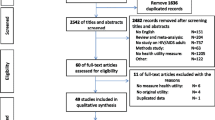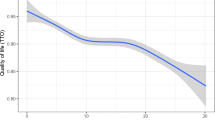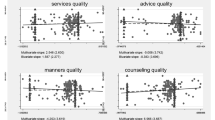Abstract
Background
Health-related quality of life (HRQoL) has become an important facet of HIV/AIDS research. Typically, the unit of analysis is either the total instrument score or subscale score. Developing a typology of responses across various HRQoL measures, however, may advance understating of patients’ perspectives.
Methods
In a multicenter study, we categorized 443 patients’ responses on utility measures (time-tradeoff, standard gamble, and rating scale) and the HIV/AIDS-Targeted Quality of Life (HAT-QoL) scale by using latent profile analysis to empirically derive classes of respondents. We then used linear regressions to identify whether class membership is associated with clinical measures (viral load, CD4, time since diagnosis, highly active antiretroviral therapy [HAART]) and psychosocial function (depressed mood, alcohol use, religious coping).
Results
Six classes were identified. Responses across the HAT-QoL subscales tended to fall into 3 groupings—high functioning (Class 1), moderate functioning (Classes 2 and 3), and low functioning (Classes 4 to 6); utility measures further distinguished individuals among classes. Regression analyses comparing those in Class 1 with those in the other 5 found significantly more symptoms of depression, negative religious coping strategies, and lower CD4 counts among subjects in Class 1. Those in Class 5 had been diagnosed with HIV longer, and members of Class 6 reported significantly less alcohol consumption, had higher viral loads, and were more likely to receive HAART.
Conclusion
Patients with HIV respond differentially to various types of HRQoL measures. Health status and utility measures are thus complementary approaches to measuring HRQoL in patients with HIV.
Similar content being viewed by others
References
Leplege A, Hunt, S. The problem of quality of life in medicine. JAMA. 1997; 278: 47–50.
Cella DF. Quality of life: the concept. J Palliat Carc. 1992;8:8–13.
Tsevat J. What do utilities measure? Med Care. 2000;38:160–4.
Turk DC. The potential of treatment matching for subgroups of patients with chronic pain: lumping versus splitting. Clin J Pain. 2005;21:44–55: discussion 69-72.
Turk DC, Rudy TE. Toward an empirically derived taxonomy of chronic pain patients: integration of psychological assessment data. J Consult Clin Psychol. 1988;56:233–8.
Turk DC, Rudy TE. The robustness of an empirically derived taxonomy of chronic pain patients. Pain. 1990;43:27–35.
Brandwin M, Trask PC, Schwartz SM, Clifford M. Personality predictors of mortality in cardiac transplant candidates and recipients. J Psychosom Res. 2000;49:141–7.
Bult JR, Bosch JL, Hunink MG Heterogeneity in the relationship between the standard-gamble utility measure and health-status dimensions. Med Decis Making. 1996;16:226–33.
Trask PC, Griffith KA. The identification of empirically derived cancer patient subgroups using psychosocial variables. J Psychosom Res. 2004;57:287–95.
Turk DC, Okifuji A, Sinclair JD, Starz TW. Pain, disability, and physical functioning in subgroups of patients with fibromyalgia. J Rheumatol. 1996;23:1255–62.
Turk DC, Okifuji A, Sinclair JD, Starz TW. Differential responses by psychosocial subgroups of fibromyalgia syndrome patients to an interdisciplinary treatment. Arthritis Care Res. 1998;11:397–404.
Rudy TE, Turk DC, Zaki HS, Curtin HD. An empirical taxometric alternative to traditional classification of temporomandibular disorders. Pain. 1989;36:311–20.
Turk DC, Sist TC, Okifuji A, et al. Adaptation to metastatic cancer pain, regional/local cancer pain and non-cancer pain: role of psychological and behavioral factors. Pain. 1998;74:247–56.
Rudy TE, Turk DC, Kubinski JA, Zaki HS. Differential treatment responses of TMD patients as a function of psychological characteristics. Pain. 1995;61:103–12.
Turk DC, Zaki HS, Rudy TE. Effects of intraoral appliance and biofeedback/stress management alone and in combination in treating pain and depression in patients with temporomandibular disorders. J Prosthet Dent. 1993;70:158–64.
Dennis ML, Wechsberg WM, McDermeit M, Campbell RS, Rasch RR. The correlates and predictive validity of HIV risk groups among drug users in a community-based sample: methodological findings from a multi-site cluster analysis. Eval Program Plann. 2001;24:187–206.
Mitchell CM, Kaufman CE, Beals J. Identifying diverse HIV risk groups among American Indian young adults: the utility of cluster analysis. AIDS Behav. 2004;8:263–75.
Bult JR, Hunink MG, Tsevat J, Weinstein MC. Heterogeneity in the relationship between the time tradeoff and Short Form-36 for HIV-infected and primary care patients. Med Care 1998;36:523–32.
Ware JE, Jr., Kosinski M, Keller SD. Sf-36 physical and mental health summary scales: a user’s manual. Boston: The Health Institute New England Medical Center; 1994.
Magidson JV, Vermunt JK. Latent class models for clustering: a comparison with K-means. Can J Market Res. 2002;20:37–44.
Magidson J, Vermunt JK. Latent class modeling as a probabilistic extension of K-means clustering. Quirk’s Market Res Rev. 2002;20: 77–80.
Lubke GH, Muthen B. Investigating population heterogeneity with factor mixture models. Psychol Methods. 2005;10:21–39.
Holmes WC, Shea JA. A new HIV/AIDS-targeted quality of life (HAT-QoL) instrument: development, reliability, and validity. Med Care. 1998; 36:138–54.
van Roosmalen MS, Stalmeier PF, Verhoef LC, et al. Randomized trial of a shared decision-making intervention consisting of trade-offs and individualized treatment information for BRCA1/2 mutation carriers. J Clin Oncol. 2004;22:3293–301.
Torrance GW. Measurement of health state utilities for economic appraisal. J Health Econ. 1986;5:1–30.
Andresen EM, Malmgren JA, Carter WB Patrick DL. Screening for depression in well older adults: evaluation of a short form of the CES-D (Center for Epidemiologic Studies Depression Scale). Am J Prev Med. 1994;10:77–84.
Malcolm SE, Ng JJ, Rosen RK, Stone VE An examination of HIV/AIDS patients who have excellent adherence to HAART. AIDS Care 2003;15: 251–61.
Pargament KI, Koenig HG, Perez LM. The many methods of religious coping: development and initial validation of the RCOPE. J Clin Psychol. 2000;56:519–43.
Pargament KI, Smith BW, Koenig HG, Perez L. Patterns of positive and negative religious coping with major life stressors. J Sci Stud Relig. 1998;37:710–24.
Chesney MA, Ickovics JR, Chambers DB, et al. Seif-reported adherence to antiretroviral medications among participants in HIV clinical trials: the AACTG adherence instruments. Patient care committee & adherence working group of the outcomes committee of the Adult AIDS Clinical Trials Group (AACTG). AIDS Care. 2000;12:255–66.
O’Connor RM, Colder CR. Predicting alcohol patterns in first-year college students through motivational systems and reasons for drinking. Psychol Addict Behav. 2005;19:10–20.
Kline RB. Principles and Practice of Structural Equation Modeling. 2nd ed., New York: Guilford Press; 2005.
Arbuckle JL. AMOS (Version 5.0.1). 2003.
Muthen B., Muthen LK. MPlus (Version 3.11). 2004.
SPSS 13.0 for Windows. 2004.
Perkins DO, Leserman J, Stern RA, et al.. Somatic symptoms and HIV infection: relationship to depressive symptoms and indicators of HIV disease. Am J Psychiatry. 1995;152:1776–81.
Pugh K, Riccio M, Jadresic D, et al. A longitudinal study of the neuropsychiatric consequences of HIV-1 infection in gay men. II. Psychological and health status at baseline and at 12-month follow-up. Psychol Med. 1994;24:897–904.
Tsevat J, Sherman SN, McElwee JA, et al. The will to live among HIV-infected patients. Ann Intern Med. 1999;131:194–8.
Szaflarski M, Ritchey PN, Leonard AC, et al. Modeling the effects of spirituality/religion on patients’ perceptions of living with HIV/AIDS. J Gen Intern Med. 2006;21:S56–61.
Sherman SN, Mrus JM, Yi MS, Feinberg J, Tsevat J. How do patients with HIV/AIDS understand and respond to health value questions? J Gen Intern Med. 2006;21:S28–38.
Behrens JT. Principles and procedures of exploratory data analysis. Psychological Methods. 1997;2:131–60.
Pentz MA, Chou CP. Measurement invariance in longitudinal clinical research assuming change from development and intervention. J Consult Clin Psychol. 1994;62:450–62.
Hu L, Bentler PM. Cutoff criteria for fit indexes in covariance structure analysis: conventional criteria versus new alternatives. Struct Equat Model. 1999;6:1–55.
Author information
Authors and Affiliations
Rights and permissions
About this article
Cite this article
Kudel, I., Farber, S.L., Mrus, J.M. et al. Patterns of responses on health-related quality of life questionnaires among patients with HIV/AIDS. J GEN INTERN MED 21 (Suppl 5), S48–S55 (2006). https://doi.org/10.1111/j.1525-1497.2006.00645.x
Issue Date:
DOI: https://doi.org/10.1111/j.1525-1497.2006.00645.x




